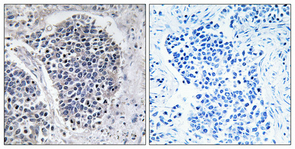JIP-3 Polyclonal Antibody
- 产品详情
- 实验流程
- 背景知识
Application
| WB, IHC-P, IF |
|---|---|
| Primary Accession | Q9UPT6 |
| Reactivity | Human, Mouse |
| Host | Rabbit |
| Clonality | Polyclonal |
| Calculated MW | 147457 Da |
| Gene ID | 23162 |
|---|---|
| Other Names | MAPK8IP3; JIP3; KIAA1066; C-Jun-amino-terminal kinase-interacting protein 3; JIP-3; JNK-interacting protein 3; JNK MAP kinase scaffold protein 3; Mitogen-activated protein kinase 8-interacting protein 3 |
| Dilution | WB~~Western Blot: 1/500 - 1/2000. Immunohistochemistry: 1/100 - 1/300. Immunofluorescence: 1/200 - 1/1000. ELISA: 1/20000. Not yet tested in other applications. IHC-P~~Western Blot: 1/500 - 1/2000. Immunohistochemistry: 1/100 - 1/300. Immunofluorescence: 1/200 - 1/1000. ELISA: 1/20000. Not yet tested in other applications. IF~~1:50~200 |
| Format | Liquid in PBS containing 50% glycerol, 0.5% BSA and 0.09% (W/V) sodium azide. |
| Storage Conditions | -20℃ |
| Name | MAPK8IP3 |
|---|---|
| Synonyms | JIP3, KIAA1066 |
| Function | The JNK-interacting protein (JIP) group of scaffold proteins selectively mediates JNK signaling by aggregating specific components of the MAPK cascade to form a functional JNK signaling module (PubMed:12189133). May function as a regulator of vesicle transport, through interactions with the JNK-signaling components and motor proteins (By similarity). Promotes neuronal axon elongation in a kinesin- and JNK-dependent manner. Activates cofilin at axon tips via local activation of JNK, thereby regulating filopodial dynamics and enhancing axon elongation. Its binding to kinesin heavy chains (KHC), promotes kinesin-1 motility along microtubules and is essential for axon elongation and regeneration. Regulates cortical neuronal migration by mediating NTRK2/TRKB anterograde axonal transport during brain development (By similarity). Acts as an adapter that bridges the interaction between NTRK2/TRKB and KLC1 and drives NTRK2/TRKB axonal but not dendritic anterograde transport, which is essential for subsequent BDNF-triggered signaling and filopodia formation (PubMed:21775604). |
| Cellular Location | Cytoplasm {ECO:0000250|UniProtKB:Q9ESN9}. Golgi apparatus {ECO:0000250|UniProtKB:Q9ESN9}. Cytoplasmic vesicle {ECO:0000250|UniProtKB:Q9ESN9}. Cell projection, growth cone {ECO:0000250|UniProtKB:Q9ESN9}. Cell projection, axon {ECO:0000250|UniProtKB:E9PSK7}. Cell projection, dendrite {ECO:0000250|UniProtKB:E9PSK7}. Cytoplasm, perinuclear region {ECO:0000250|UniProtKB:E9PSK7}. Note=Localized in the soma and growth cones of differentiated neurites and the Golgi and vesicles of the early secretory compartment of epithelial cells. KIF5A/B/C-mediated transportation to axon tips is essential for its function in enhancing neuronal axon elongation. {ECO:0000250|UniProtKB:E9PSK7, ECO:0000250|UniProtKB:Q9ESN9} |
For Research Use Only. Not For Use In Diagnostic Procedures.
Provided below are standard protocols that you may find useful for product applications.
BACKGROUND
The JNK-interacting protein (JIP) group of scaffold proteins selectively mediates JNK signaling by aggregating specific components of the MAPK cascade to form a functional JNK signaling module (PubMed:12189133). May function as a regulator of vesicle transport, through interactions with the JNK-signaling components and motor proteins (By similarity). Promotes neuronal axon elongation in a kinesin- and JNK-dependent manner. Activates cofilin at axon tips via local activation of JNK, thereby regulating filopodial dynamics and enhancing axon elongation. Its binding to kinesin heavy chains (KHC), promotes kinesin-1 motility along microtubules and is essential for axon elongation and regeneration. Regulates cortical neuronal migration by mediating NTRK2/TRKB anterograde axonal transport during brain development (By similarity). Acts as an adapter that bridges the interaction between NTRK2/TRKB and KLC1 and drives NTRK2/TRKB axonal but not dendritic anterograde transport, which is essential for subsequent BDNF-triggered signaling and filopodia formation (PubMed:21775604).
终于等到您。ABCEPTA(百远生物)抗体产品。
点击下方“我要评价 ”按钮提交您的反馈信息,您的反馈和评价是我们最宝贵的财富之一,
我们将在1-3个工作日内处理您的反馈信息。
如有疑问,联系:0512-88856768 tech-china@abcepta.com.























 癌症的基本特征包括细胞增殖、血管生成、迁移、凋亡逃避机制和细胞永生等。找到癌症发生过程中这些通路的关键标记物和对应的抗体用于检测至关重要。
癌症的基本特征包括细胞增殖、血管生成、迁移、凋亡逃避机制和细胞永生等。找到癌症发生过程中这些通路的关键标记物和对应的抗体用于检测至关重要。 为您推荐一个泛素化位点预测神器——泛素化分析工具,可以为您的蛋白的泛素化位点作出预测和评分。
为您推荐一个泛素化位点预测神器——泛素化分析工具,可以为您的蛋白的泛素化位点作出预测和评分。 细胞自噬受体图形绘图工具为你的蛋白的细胞受体结合位点作出预测和评分,识别结合到自噬通路中的蛋白是非常重要的,便于让我们理解自噬在正常生理、病理过程中的作用,如发育、细胞分化、神经退化性疾病、压力条件下、感染和癌症。
细胞自噬受体图形绘图工具为你的蛋白的细胞受体结合位点作出预测和评分,识别结合到自噬通路中的蛋白是非常重要的,便于让我们理解自噬在正常生理、病理过程中的作用,如发育、细胞分化、神经退化性疾病、压力条件下、感染和癌症。

.jpg)






